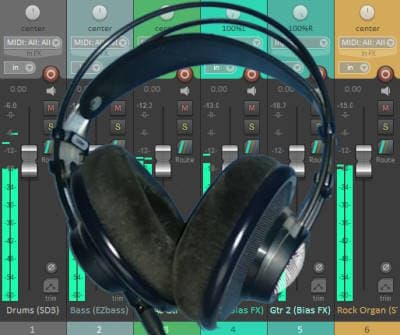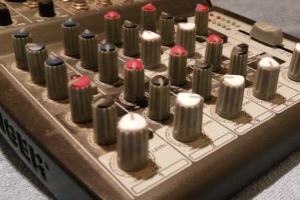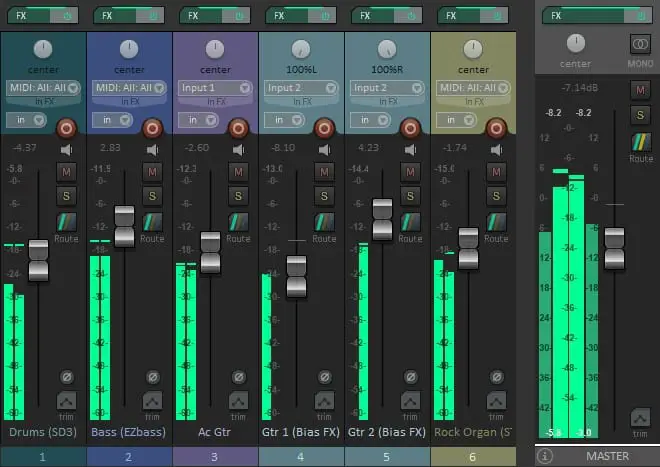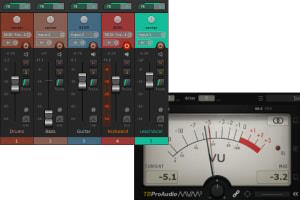Should you compress every track?
Compression is one of those effects that I have used on pretty much all the songs I have recorded in my home studio. It has helped even out the volumes on many of my tracks. However, this does not mean I put compression on every track without any consideration.
You should not compress every track in your song automatically. Compression should be applied to tracks that have a large difference in volume between the loudest and quietest parts. It can also be used to add energy to a track. It is perfectly acceptable to have a track with no compression on it.
There is no doubt that compression is one of the most powerful tools we have in our arsenal when mixing our songs. But as with most powerful tools, it is easy to overuse and make your tracks actually sound worse. This article discusses how you should decide when to apply compression, and when you shouldn’t.
As a side note, I also wrote a beginners guide to mixing in general. I highly recommended you check it out if you are new to mixing. It clears up some of the confusion novice mixers often have, and helps you avoid some common mixing pitfalls.
If you are interested in checking out the best recording gear such as audio interfaces, studio monitor speakers, microphones, etc., you can find them at Amazon by clicking here.

Don’t automatically compress every track
As useful as compression is, it also has the potential to be harmful to your song. You risk squeezing all the dynamics out of your tracks, turning a good performance into a lifeless mix devoid of any emotion.
For this reason, you should never automatically apply compression to any track in your song. Each track should be assessed on its merits, and if it warrants some compression then it’s fine to apply some to that track.
So how do you decide if a track needs some compression adding?
Deciding if a track needs compression
Take each of your tracks in your mix in turn, and listen carefully to the whole track. But there is one very important point to keep in my mind when you do this…
Listen to your whole mix, not your solo’d tracks
Do not make decisions on whether to use compression based on listening to your solo’d tracks! Listen to them in the context of your whole mix i.e. all your tracks playing at the same time. This applies to all mixing decisions, not just compression.
You don’t care how your tracks sound on their own. You only care how they sound when they are played together, in the actual song that listeners will hear.
For example, your lead vocal track might be completely clear and sound great on its own, but when you play it with your other tracks suddenly some lyrics can’t be heard clearly, some lines are overpowered by the lead guitar, etc. It is these criteria that you need to hear to be able to make decisions on compression.
If you’re trying to determine if your tracks need compressing, a quality pair of headphones are essential. I highly recommend the AKG K-702 Reference Headphones (affiliate link), which you can get at Amazon for a very reasonable price. I have always got great results with these headphones – I have mixed three commercially released EPs on them.
Compare loudest and quietest sections
While listening to one of your tracks, ask yourself the following questions…
- Is there a wide variation in dynamics i.e. does it go very loud and very quiet?
- Is there a big difference in volume between the loudest and quietest parts of your track?
- Are there parts of the track that you can’t hear very clearly?
- Are there any parts that suddenly make you jump!?
- Are you constantly moving a track’s fader up and down when listening to your mix?
If any of these are true, it is likely that your track could benefit from some compression. Try starting off with some conservative settings in a compressor plugin on your DAW. See if that helps keep the track more present, and makes the unclear parts more audible while taming the more overpowering parts.
Experiment with the settings, but always err on the side of less rather than more. Remember that the aim is not to make the track all exactly the same volume; that would destroy the expression and life in your recorded performances. You are trying to smooth out huge volume differences, and make sure that everything can be clearly heard that needs to be.
Compression these days is most often applied via plugins. One of the most common type of plugin is the VST plugins. I am often asked what is the difference between VST and VSTi plugins? Check out my article on VST vs VSTi plugins for the answer.
What is compression?
Compression is smoothing out the differences in volume in a track. It makes the loud bits quieter, and the quiet bits louder. This effectively compresses the audio waveform; the peaks won’t go as high and the troughs won’t go as low.
This is achieved in a compressor plugin by setting a dB threshold. Everything that is louder than this threshold will get made quieter. You can then apply some “make-up gain” to bring up the volume of the whole track.
You can hear the need for compression if you’ve ever listened to classical music in a car. Because classical music is very dynamic (it goes very loud and very quiet), you need to keep turning up the volume for the quiet bits to get over the engine noise. Then when a loud bit comes in, you have to turn the volume down to avoid getting deafened!
Commercial pop music is heavily compressed, which is why you generally don’t have to do this when listening to pop radio.
Beginners in music production sometimes get confused between EQ and compression. My article on the difference between EQ and compression explains the difference, and lays out what each one is used for and when to use them. It’s recommended reading if you are a novice in recording and mixing.
Sometimes compression is not the answer
Supposing there’s just one short section of your track that is louder than the rest, and the volume of the rest of the track is actually quite consistent.
This may be a case where it would be better to just edit the audio volume of the loud section to be quieter, rather than compress the whole track. This way you leave the natural dynamics of the track, but eliminate the annoying loud bit.
If you’re interested in whether you should apply compression to every track, you’re probably also interested in the same thing regarding EQ. My “Should You EQ Every Track” article discusses exactly that, and will greatly help you decide when to use EQ in your songs. The companion article “What do EQ numbers mean” is also a great resource for learning EQ terminology if you are a beginner.
Creative reasons for adding compression
Volume consistency is not the only reason for adding compression.
Adding energy
Maybe your track is a little lacking in energy even though the volume is consistent. Compression could help put a bit more oomph into it. Try some gentle compression, then turn up the make-up gain a little.
Why does this add energy? It turns up the volume of even the quieter bits, so even if your louder sections are the same volume, the quieter bits will be louder. The overall effect is to make it sound like the track stands out more.
Adding warmth
Vintage old analog compressors had particular tonal characteristics which altered the sound of a track in addition to smoothing the volume. They added a “warmth” similar to a traditional guitar amp, which is considered a very desirable sound.
Fortunately for us, there are many software emulations of vintage analog compressors available to us today in the form of VST plugins. These add a similar vintage analog warmth to your audio. This can help add the finishing touch to your song.
The Arturia Comp FET-76 is an excellent example of a software emulation of a vintage hardware compressor.
Getting it right at the recording stage
I like to leave recordings as natural as possible. Some people don’t, and prefer to have a more processed, polished sound. Both approaches are absolutely valid, depending on the style of music and personal preference.
It can be difficult to decide whether to record with effects, or leave applying your effects until the mixing stage. That’s why I wrote this article: “Is it better to record with or without effects?“. If you are relatively new to music production I highly recommend reading it for several different approaches on where to apply effects appropriate to your music.
In either case, you can make your job at the mixing stage massively easier by getting it right on the way in i.e. getting your volume as consistent as possible when you are recording. Do this right, and you can eliminate the need to apply any compression later on.
For example, don’t record vocals with the singer right up very close to the mic. Singers are never still – they are always making movements as they perform, which is absolutely what we want; whatever helps them give the best performance.
But when they are very close, even minor movements can result in a big difference in volume. If they lean back, there will be a significant drop in volume the mic picks up.
When the singer is further back from the microphone, the effect of these movements is much reduced. This helps keep the volume consistent, and will mean if you do have to use any compression at the mixing stage it should be with relatively conservative settings.
One absolutely essential piece of equipment for recording is a good audio interface. I have been using Focusrite Scarlett interfaces for years, and they have always given me great sounding recordings for not very much money. You can buy the Focusrite Solo from Amazon (affiliate link) for a very reasonable price.
Should you avoid using compression presets?
All compression plugins come with built-in “presets“. These are groups settings that you can select that are designed to be used for a particular compression application. e.g. there might presets called “acoustic guitar”, “backing vocals”, “master bus glue”, etc.
Some people will tell you that you should never use presets. I think this is a little drastic, and I believe presets do have a valid use.
I think presets are an excellent starting point. This is where I think presets have a place; saving you time getting initial compression onto a track.
Take the hypothetical “acoustic guitar” preset mentioned earlier. If you have an acoustic guitar recorded, try this preset on it if you think the track needs compression.
The important thing is to not just apply the preset and think you’re finished. Every track and song is different, and there are no magic settings you can just use to make your track sound great. If there were, computers could mix songs and mixing engineers would all be out of a job!
Listen carefully to your song and change the settings according to what best fits your music. You will almost always want to modify the settings from the original preset.
You may be faced with a choice on whether you should use a stock or a 3rd party compression plugin. There is often a heated debate on whether stock or 3rd party plugins are better. My article on third-party vs stock plugins gives you the lowdown on whether you need the 3rd party ones, or if the ones supplied with your DAW will give you just as high-quality a sound.
Should you compress the master track?
You should not compress the master track automatically. However, a little compression applied to the master track can help your song sound more cohesive and add punchiness to it. Use subtle settings and compare with the uncompressed track to determine if your master track benefits from compression.
Does Bass always need compression?
Bass does not always need compression. The sound you are trying to achieve and playing style determines whether compression is needed. Compression will give you a full consistent bass presence in your mix. Very dynamic bass parts can also benefit to smooth out the volume differences.
Should you compress guitars?
As a general rule, electric guitars don’t require compression as they are already compressed. Guitar amps compress the signal, particularly with overdriven sounds, so additional compression is not necessary. Compression will generally only be needed if you are using a very clean sound.
Should I compress my acoustic guitar?
Generally, you should compress your acoustic guitar for a strummed chord or background texture part requiring consistent volume. If the guitar is more in the foreground such as a finger-picked lead part in a simple singer and guitar mix, don’t compress to capture the natural sound of the guitar.
Here is some of my favorite home studio gear…
Thanks for reading this article. I hope you found it helpful in your home music-making activities. Here are a few of the tools that I personally use in my home studio. These are affiliate links, so if you decide to use any of them I’ll earn a small commission.
Audio interface: My personal choice for audio interfaces are the Focusrite Scarlett series. I have been using these for years, and they have always given me great-sounding recordings. For a very reasonable price from Amazon you can buy the excellent Focusrite Scarlett 4i4, or if you don’t need MIDI capability the Focusrite Solo is a great choice.
Amp sim: Guitar amplifier simulator software has come on leaps and bounds in recent years, such that I record all my electric guitar parts using amp sims these days. One of the very best is the incredible Amplitube from IK Multimedia, which I have used on many of my songs.
Headphones for recording: My favorite headphones for recording are the Sony MDR-7506s, which I use for monitoring during all my recording sessions. They can also be found in many pro recording studios. Get the Sony MDR-7506 headphones from Amazon here.
General-purpose microphone: You can’t go wrong with a good ol’ Shure SM-57, one of the most versatile and ubiquitous microphones around. I’ve been using one in my home studio for as long as I can remember. Amazon offers the Shure SM-57 for a very competitive price.
To see all of my most up-to-date recommendations, check out this resource I made for you!






